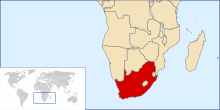
Back Suid-Afrikaanse kookkuns Afrikaans Gastronomía de Sudáfrica AST CAR mətbəxi Azerbaijani Kuchyně Jihoafrické republiky Czech Südafrikanische Küche German Gastronomía de Sudáfrica Spanish آشپزی آفریقای جنوبی Persian Etelä-Afrikan keittiö Finnish Cuisine sud-africaine French המטבח הדרום-אפריקאי HE
| Part of a series on the |
| Culture of South Africa |
|---|
 |
| People |
| Cuisine |
| Religion |
| Art |
| Sport |


South African cuisine reflects the diverse range of culinary traditions embodied by the various communities that inhabit the country. Among the indigenous peoples of South Africa, the Khoisan foraged over 300 species of edible food plants,[1] such as the rooibos shrub legume,[2] whose culinary value continues to exert a salient influence on South African cuisine. Subsequent encounters with Bantu pastoralists facilitated the emergence of cultivated crops and domestic cattle, which supplemented traditional Khoisan techniques of meat preservation.[3] In addition, Bantu-speaking communities forged an extensive repertoire of culinary ingredients and dishes, many of which are still consumed today in traditional settlements and urban entrepôts alike.
- ^ Arnold, T. H.; Wells, M. J.; Wehmeyer, A. S. (1985), Wickens, G. E.; Goodin, J. R.; Field, D. V. (eds.), "Khoisan food plants: taxa with potential for future economic exploitation", Plants for Arid Lands: Proceedings of the Kew International Conference on Economic Plants for Arid Lands held in the Jodrell Laboratory, Royal Botanic Gardens, Kew, England, 23–27 July 1984, Dordrecht: Springer Netherlands, pp. 69–86, doi:10.1007/978-94-011-6830-4_6, ISBN 978-94-011-6830-4
- ^ Ives, Sarah (2014). "Farming the South African "Bush": Ecologies of belonging and exclusion in rooibos tea". American Ethnologist. 41 (4): 698–713. doi:10.1111/amet.12106. ISSN 1548-1425.
- ^ Erasmus, Sara Wilhelmina; Hoffman, Louwrens Christiaan (1 October 2017). "What is meat in South Africa?". Animal Frontiers. 7 (4): 71–75. doi:10.2527/af.2017.0449. ISSN 2160-6056.